It's fair to say that in the last five years there has been a low-budget zombie boom. Spurred by the DIY attitudes that brought us The Evil Dead and Bad Taste (along with a bit of get rich quick thrown in), every young horror fan with a group of friends and a camera have tried to make their own Night Of The Living Dead, with the results being of wildly varying quality. Thanks to the success of 28 Days Later and the remake of Dawn Of The Dead, video store shelves are littered with dozens of these films (with literally hundreds available online), with more coming all the time, meaning it's as difficult as it has ever been for film-makers to distinguish themselves. To that end, Richard Chance's The Veil is something a bit different. Filmed over a four year period on a nothing budget, shot almost entirely in black and white and running over two and a half hours, it shows a level of ambition and dedication rarely seen in low budget film-making. This ambition can come with a price, however, as The Veil is often as bloated and frustrating as it is frequently inspired.
An airborne virus has been accidentally released on a British town, turning all of the occupants into lumbering, flesh eating zombies. A group of Special Air Service agents are sent in to investigate, but rapidly find their numbers dwindling and radio contact cut off. The three remaining men; Green, Anderson and Weston, hold up in an abandoned house while zombies surround them on all sides. Fighting off claustrophobia and infighting, they have to keep it together and find their way to safety before the shuffling masses rip them to pieces.
The Veil is, if nothing else, a significant achievement. While most microbudget horror is short on suspense and struggles to reach the 90 minute mark, Chance and crew tell their story effectively while pouring on significant amounts of atmosphere. Aided by a terrific soundtrack, and some smart, punchy direction that rarely lets things slow down, the film works on a level that even hollywood productions sometimes have trouble achieving. The crew was obviously unwilling to cut corners during production, and their efforts pay off in creating something unique
The choice to film in B&W was likely one of necessity. Different cameras and lighting set-ups likely created an inconsistent look to the film that is evened out by the lack of color, though even if it was planned from the beginning it ends up being a smart move. This doesn't feel like a hand-held Blair Witch knockoff, but like a real film that evokes memories of Romero's original Night Of The Living Dead while still feeling modern. One scene has a character shooting out the lights, bathing a room in darkness as some zombies approach. The only lighting comes from some persistent lightning outdoors and the muzzle flashes from the guns, and though it's a simple effect (and goes on a little long) it's very effective and a highlight. Even when the lighting is less effective, it's generally not difficult to tell what is going on, which is helped by some great editing which takes advantage of the numerous camera setups which increases the cinematic look of the proceedings.
Unfortunately, while the editing of the individual scenes is well done, the editing as a whole is where the film runs into trouble. It's just too damn long. Forty-five minutes could easily be shaved from the runtime without losing anything significant, particularly from the sometimes endless scenes of the soldiers mowing down zombies as they enter the house. While these scenes increase the sense of danger that these men are living with, they also are simply too frequent and become tiresome. We're also faced with several flashbacks throughout the running time, and while they effectively serve to illuminate the backstory and give the film a few more settings, the transitions into the scenes are often confusing.
Speaking of confusing, the other major flaw of the film is having the three main cast members spend almost the entire film wearing gas-masks. While i'm sure this decision was made out of necessity (since the actors played multiple parts and are also crew members), it also serves to make distinguishing who is who virtually impossible. While this may be by design, it makes for an irrirating viewing experience, particularly when combined with difficulty in understanding much of the dialogue in the film. The actors all have strong British accents, and it appears that little of the dialogue was dubbed in afterward, so we're left with a lot of lines that are difficult to make out. There is little dialogue in the film as a whole, and it never gets to the point where things are too confusing, but it does make some of the twists and turns in the plot difficult to keep track of.
The acting of the three leads is fine, though again hurt by the muffled sound, but I was quite impressed with the zombie acting in the film. Some effort was made in making up the zombies (though, it sometimes vears into "oatmeal face" territory), but it's their ability to lurch around and lunge when close to their victims which make them most effective. Add to that a wide variety of looks (and the near constant moaning on the soundtrack), and it isn't difficult to believe that the house is being surrounded by throngs of the living dead.
The special effects are equally impressive, and feature some great gory fun, particularly a chainsaw attack which owes a bit to the work of Peter Jackson. Gunshots are achieved usually through camera tricks and a few unconvincing digital blasts, but there also appear to be actual replica guns and blanks utilized in a few scenes. There are plenty of vicious headshots and spurting blood (though these are not Romero zombies which go down from a destroyed brain), and while not a gorefest the film-makers never appear to be holding back.
A mention must be made about the terrific soundtrack which features music from the bands Halo Ego Trip, Quartet, and incidental music from the director. Reminiscent of both John Carpenter's minimalist scores as well as the atmospheric soundtrack to 28 Days Later, it serves to maintain and build the film's tension while rarely overwhelming the action onscreen. It's quite memorable, and deserves a release in its own right.
Mill Creek/Pendulum Pictures were right to only squash four films onto the third disc of their Bloody Nightmares collection, keeping The Veil from devolving in a pixelated mess. The film is presented full-screen, and while the image is sometimes dark and grainy, it's only in the final twenty minutes that things get a little difficult to see. As with many films in this collection, I noticed a few digital glitches throughout, but it's nothing that can't be ignored.
A flawed but excitingly ambitious entry in the zombie genre, Richard Chance's The Veil may be a bloated & unwieldy mess, but makes up for it with sharp direction and interesting visuals. Casual viewers may be scared away by the black & white photography and epic running length, but for patient genre fans there is a lot to love here. Worth checking out.

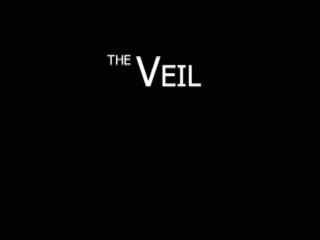
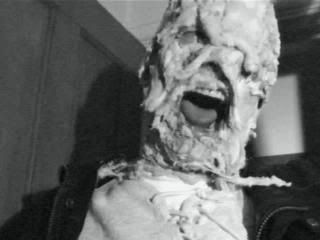
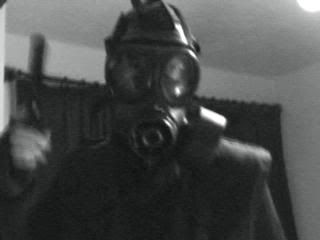
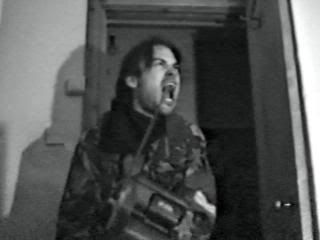
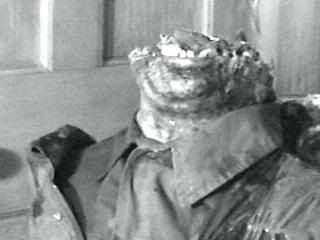
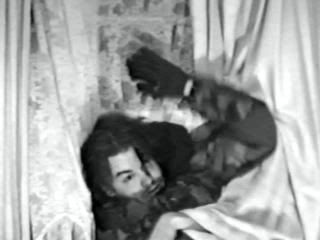
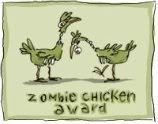








1 comment:
Based on your screenshots, it looks like it's filmed entirely in close up.
I'm somewhat embarrassed that your reviews for these zero-budget films are much more detailed than my reviews for "legitimate" cinema.
Post a Comment